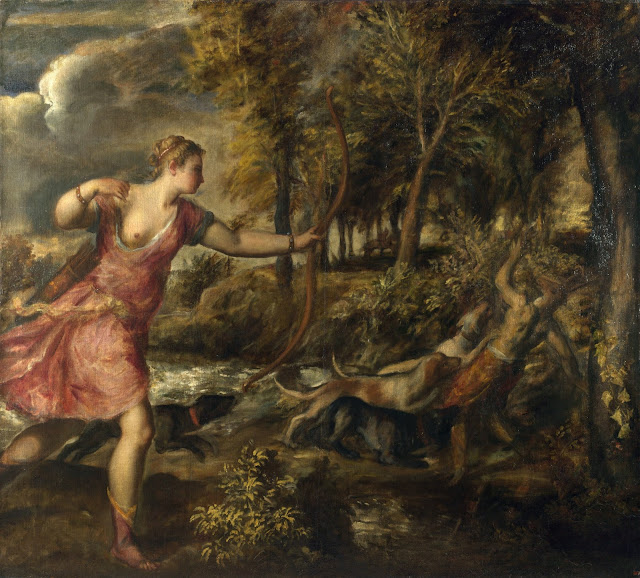 |
| Titian Adam and Eve ca. 1550 oil on canvas Museo del Prado, Madrid |
 |
| Titian Ecce Homo ca. 1565-70 oil on canvas Museo del Prado, Madrid |
 |
| Titian Christ and Simon the Cyrenian ca. 1560 oil on canvas Museo del Prado, Madrid |
 |
| Titian David and Goliath 1542-44 oil on canvas Basilica di Santa Maria della Salute, Venice |
"I find Titian's great and special virtue his ability to transform the canvas so completely in the interest of the illusion of mass and volume. This was the central interest of five centuries of Western painting, and it makes Titian the central and perhaps supreme master of those five centuries. Other painters have worked more sculpturally, still other painters have given a more emphatic version of deep or distant space, but none has achieved statements of the illusion, as such, of the third dimension that are equally convincing, full, and integrated. None has so thoroughly possessed a flat surface for the sake of that illusion or – to be even more exact – surrendered so little of the illusion for the sake of that surface. Yet Titian does not violate what is called the integrity of the picture plane; there are few "holes" in his paintings, few protruding bosses. It is not a question of trompe-l'œil with him; he does not model and tint toward the end of a complete naturalism, for the simple sake of likeness to nature. His illusion is original and harmonious, and something that is a means; it is the illusion of the three-dimensional world that can be most convincingly rendered with paint on canvas as art."
"The principal factor in this art is color – color modulated according to a scheme of dark and light values such as is deemed best fitted to endow flat colored surfaces with the illusion of volume. Titian's color has substantiality of texture that makes it hard to conceive that it is the product of thin layers of paint spread on a sheet of canvas; one has the impression of configurations that well up out of infinite real space – as if the reverse as well as the obverse side of the canvas had been transformed by paint. Or as if the very threads of the fabric had been dissolved into pigment so that the picture consisted entirely of paint without a supporting surface. And yet – this is the contradiction essential to the art – the supporting surface that we know to be actually there is not denied in its flatness, and we feel this without feeling any the less the illusion that it is not there."
 |
| Titian Death of Actaeon 1570s oil on canvas National Gallery, London |
 |
| Titian Entombment 1559 oil on canvas Museo del Prado, Madrid |
 |
| Titian Entombment 1572 oil on canvas Museo del Prado, Madrid |
 |
| Titian Man with a quilted sleeve ca. 1510 oil on canvas National Gallery, London |
 |
| Titian Portrait of a man holding a book ca. 1540 oil on canvas Museum of Fine Arts, Boston |
 |
| Titian Vendramin family venerating a Relic of the True Cross ca. 1540-45 oil on canvas National Gallery, London |
 |
| Titian Portrait of Doge Andrea Gritti ca. 1545 oil on canvas National Gallery of Art, Washington DC |
 |
| Titian Salome with Head of John the Baptist ca. 1550 oil on canvas Museo del Prado, Madrid |
 |
| Titian St Margaret and the Dragon ca. 1565 oil on canvas Museo del Prado, Madrid |
 |
| Titian Tityus 1548-49 oil on canvas Museo del Prado, Madrid |
"Oil on canvas suggests 'open' rather than 'closed' forms, loose rather than tight contours, broken rather than smooth, uniform colors, transparent and vibrating rather than opaque surfaces. Oil fulfills itself on canvas when the painter draws with a full brush, with color and its masses, instead of tinting or filling in a prepared outline. Then the painter invents form with his brush, not his pencil, and sees everything in terms of transition rather than sharp separation."
– quoted passages are from two essays by Clement Greenberg published in Partisan Review and describing his characteristically complex responses to an exhibition at the Metropolitan Museum mounted in the spring of 1950 which featured masterpieces on loan from the Kunsthistorisches Museum in Vienna (the paintings reproduced above do not correspond to those in the exhibition)